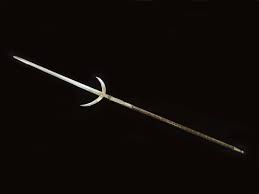In this article, you will be exploring the Septum. A polearm That was used in Medieval Europe to great effect. You will see what was the Septum, how it was used, and how effective it really was. Now, as always I will give you the main takeaway of the article before going into more detail.
Starting with the main question … What was a Septum?
Septum was a type of polearm that was used in medieval Europe. It consisted of a long shaft with a spearhead on one end and a hooked blade on the other. It was often used by infantry to repel cavalry charges and was particularly effective against horses. Soldiers would use the spearhead to strike at the horses, and then use the hooked blade to pull the riders off their mounts. The use of Septum declined as firearms became more prevalent on the battlefield.
That was the main takeaway of the entire article. Now, let’s explore this dangerous polearm in a little more detail Starting with its origin.
Origin Of The Septum
Septum has its origin in Medieval Europe. Its design is believed to have been influenced by the glaive. Which was a similar weapon in terms of functionality. So it is likely that its design was later modified to create the septum.

And now that we briefly looked at the origin of Septum, it’s time we take a look at a famous battle where Septum was used to great effect.
Famous Battle Where It Was Used
One such battle where Septum was used was the Battle of Courtrai, fought in 1302 between the French and the Flemish. The Flemish used Septums to great effect, causing significant damage to the French knights. We will see how the Septum was used against knights a little further down the article. Suffice it to say … it was very effective.
Now, let’s take a look at the dimensions of Septum.
Dimensions Of Septum
So, how long was the Septum?
Septum had a total length of about 2 to 3 meters, with the blade at the end measuring around 30 to 45 centimeters of the total length. The blade itself was angled to allow for greater impact and penetration.
And now that we have covered the dimensions of Septum, let’s check out the materials used to make it.
Materials Used To Make A Septum
Septum was made using a combination of iron and steel. The blade was crafted from high-quality steel, while the socket was made of iron to provide greater durability and strength. The shaft was made from hardwood such as ash or oak, which could withstand the force of impact during use. The use of ash or oak for the shaft portion of the weapon was extremely popular in the Middle Ages. The reason?
It was just plain effective and cheap enough to equip larger armies with weapons made from these woods.
And now let’s move on to how it was used in battle.
Septum in Battle Tactics and Techniques
As you will see Septum was used in a variety of ways in battle.
Soldiers using Septum would often form up into tight formations, such as a hedgehog. With the spearheads facing outward. This made it difficult for cavalry to charge through the formation, and if the cavalry did make it through, the soldiers would use the hooked blades to pull riders from their mounts.
Septum was also effective against other types of infantry. Since the spearhead could be used to strike at enemies from a distance, while the hooked blade was used to pull enemies off balance or disarm them.
Now, let’s take a look at how Septum compared to other polearms of the era.
Comparison To Other Polearms
Septum had a shorter blade and a longer shaft than the let’s say the halberd. Which made it easier to maneuver in close combat. The pike, on the other hand, had a longer shaft than the Septum, making it better suited for keeping enemies at a distance. So, while the Septum was a better polearm than the halberd it fell short when compared to the pike.
And now that we have compared Septum to other polearms of the era, let’s discuss why it disappeared from the battlefield.
Disappearance From The Battlefield
Septum disappeared from the battlefield as firearms became more effective at the end of the medieval period. Firearms also had a greater range and could penetrate armor more effectively than polearms. This made them a more effective weapon in battle.
This means that Septum and other polearms just could not compete. Muskets were more effective at greater ranges. And a lot cheaper too!
The downfall of the Septum mimics closely what happened to the guisarme polearm, which you can see here.
In Conclusion
Thank you for taking the time to read this article. And I hope to see you at the next one. I suggest taking a look at this polearm that the Scots used to hammer the English.
Take care!
Source:
“The Knight and the Blast Furnace” by Alan Williams
“European Polearms, 14th-18th Centuries” by D. Sim and P. Wagner